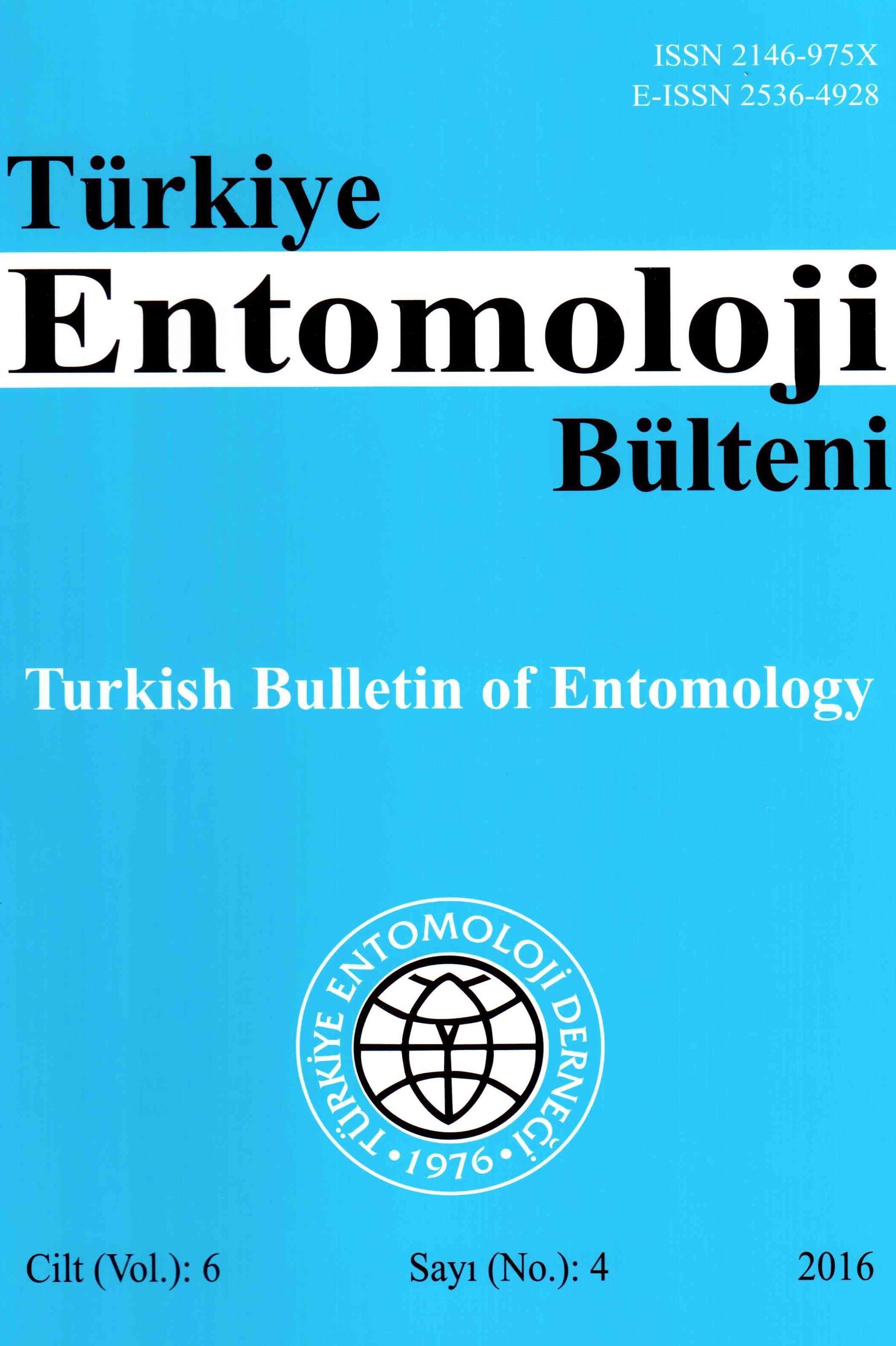Chelostoma Latreille (Hymenoptera: Megachilidae, Osminii) species occurring in Turkey with their zoogeographic characterization
1959’dan günümüze kadar 30’dan fazla profesyonel ve amatör entomoloji uzmanları veya değişik ziyaretçiler tarafından Anadolu’dan toplanan 1000 civarındaki Chelostoma örneği faunal ve zoocoğrafik yönden değerlendiril-miştir. Yirmibeş türün Anadolu’da bulunduğu belirlenmiş, bunlardan en yaygın ve yoğun olanının Chelostoma diodon Schletterer 1889 olduğu gözlenmiştir Dünyada bulunan toplam 49 ve Palearktik Bölge’deki 40 türle karşılaştı-rıldığında; Anadolu’nun Chelostoma çeşitliliği yönünden oldukça zengin olduğu görülmektedir. Zoocoğrafik analiz yönünden 25 Chelostoma türü değerlendirmeye alınmış ve sekiz temel korolojik kategori sıralanmıştır: Holarktik Bölge (2), Avrupa (6), GB-Asya (7), D-Akdeniz (1), Turanian (2), Turano-Avrupa (2), Merkeziasya-Avrupa (1) ve Anadolu endemik (4). Ayrıca iki tür Armeno-D-Anadolu endemic durumundadır. Oniki türün de tip lokalitesinin Anadolu olduğu görülmüştür. Holarktik, Avrupa ve Turano-Avrupa korotiplerine giren türlerin (10 tür) büyük olasılıkla Avrupa orijinli oldukları ve oradan Anadoluya yayılmış oldukları düşünülmektedir. Değişik korotiplere ait geri kalan türlerin ise Anadolu orijinli olup buradan çevreye yayıldıkları muhtemeldir.
Anahtar Kelimeler:
Megachilidae, Hymenoptera, Osminii, Chelostoma, fauna, korotip, Türkiye
Türkiye’deki Chelostoma Latreille (Hymenoptera: Megachilidae, Osminii) türleri ve bunların zoocoğrafik karakterleri
Summary
On the basis of about 1000 bee specimens have been collected by more than 30 professional and ameteur entomologists or various visitors since 1959, a synthesis is presented of the present knowledge of the Chelostoma fauna of Anatolia from faunistic and zoogeographical points of view. Twenty-five species have been noted occurring in Anatolia. Among them Chelostoma diodon Schletterer 1889 is the most common and abundant species. The Chelostoma fauna of Anatolia seems to present a relatively high diversity, if compared to the total 49 species worldwide and 40 species in Palaearctic. For the zoogeographical analysis, 25 Chelostoma species have been considered and the main chorological categories are represented as follows: Holarctic Region (2), European (6), SW-Asiatic (7), E-Mediterranean (1), Turanian (2), Turano-European (2), Centralasiatic-European (1) and Anatolian endemics (4). Moreover, type localities of 12 species are Anatolia; two species are Armeno -E-Anatolian endemics. Species in the Holartic, European and Turano-European chorotipes (10 species) are most probably European origine and spread to Anatolia from Europa. The remaining species were originated in Anatolia and were spread from here to neighboring countries.
Keywords:
-,
___
- Amiet, F., M. Herrmann, A. Müller, & R. Neumeyer, 2004. Apidae 4: Anthidium, Chelostoma, Coelioxys, Dioxys, Heriades, Lithurgus, Megachile, Osmia, Stelis. Fauna Helvetica. Vol. 9. Centre Suisse de Cartographie de la Faune (CSCF)/Schweizerische Entomologische Gesellschaft (SEG), 274 pp.
- Banaszak, J. & L. Romasenko, 2001. Megachilid Bees of Europe (Hymenoptera, Apoidea, Megachilidae). 2nd edn (corrected and supplemented). Bydgoszcz University, Bydgoszcz, 239 pp.
- Benoist, R., 1928. Un Heriades nouveau d’Asie mineure (Hyménopt.). Annales de la Annales de la Societe Entomologique de France, 97: 418.
- Benoist, R., 1935. Descriptions d’espèces nouvelles paléarctiques du genre Heriades (Hym. Apidae). Bulletin de la Société Entomologique de France, 40: 277-280.
- Bosch, J. & W. P. Kemp, 2002. Developing and establishing bee species as crop pollinators: the example of Osmia spp. (Hymenoptera: Megachilidae) and fruit trees. Bulletin of Entomological Research, 92: 3-16.
- Cane, J. H., T. Griswold, & F. D. Parker, 2007. Substrates and materials used for nesting by North American Osmia bees (Hymenoptera: Apiformes: egachilidae). Annals of the Entomological Society of America, 100: 350-358.
- Engel, M. S., 2005. Family-group names for bees (Hymenoptera: Apoidea). American Museum Novitates (New York), 3476:1-33.
- Friese, H., 1899. Neue Arten der Bienengattung Osmia (Palaearktisches Gebiet). Entomologische Nachrichten (Berlin) 25: 25-27, 61-64.Friese, H., 1911. Apidae I Megachilinae. Das Tierreich, 28, 440 pp.
- Gogala, A., 1999. Bee fauna of Slovenia: Checklist of species (Hymenoptera: Apoidea). Scopolia, 42:1-79.
- Mavromoustakis, G. A., 1951. On the bees (Hymenoptera, Apoidea) of Cyprus. Part II. The Annals and Magazine of Natural History (London), ser. 12 ( 4): 334-354.
- Michener, C. D., 2007. The Bees of the World, second edition. Johns Hopkins University Press, Baltimore and London, 953 pp.
- Michez, D., S., Patiny, & B. Danforth, 2009. Phylogeny of the bee family Melittidae (Hymenoptera: Anthophila) based on combined molecular and morphological data. Systematic Entomology, 34: 574-597.
- Müller, A., 2010. Palaearctic Osmiine Bees, ETH Zürich, (Web page: http://blogs.ethz.ch/osmiini), (Date accessed: January 2011).
- Müller, A., A. Krebs, & F. Amiet, 1997. Bienen: Mitteleuropäische Gattungen, Lebensweise, Beobachtung. Naturbuch Verlag, Augsburg, 384 pp.
- Özbek, H. & G. van der Zanden, 1992. A preliminary review of the Megachilidae of Turkey, Part II. Heriadini (Hymenoptera: Apoidea). Türkiye Entomologji Dergisi, 16: 129-134.
- Schletterer, A., 1889. Monographie der Bienen-Gattungen Chelostoma Latr. und Heriades Spin. Zoologisches Jahrbuch für Systematik, 4: 591-691.
- Schletterer, A., 1890. Apidarum species novae descriptae. Entomologische Nachrichten (Berlin), 16: 225-238.
- Schwarz, M. & F. Gusenleitner, 2000. Weitere Angaben zur Bienenfauna Österreichs sowie Beschreibung einer neuen Chelostoma-Art aus der Westpaläarktis. Entomofauna (Ansfelden), 21: 133-164.
- Sedivy, C., C. J Praz, A. Müller, A. Widmer & S. Dorn, 2008: Patterns of host-plant choice in bees of the genus Chelostoma: the constraint hypothesis of host-range evolution in bees. Evolution, 62: 2487-2507.
- Vigna-Taglianti, A., P. A. Audisio, M. Biondi, M. A. Bologna, G. M. Carpaneto, A. Biase, S. Fattorini, E. Piattella, R. Sidaco, A. Venchi & M. Zapparolu, 1999. A Proposal for a chorotype classification of the near fauna, in the framework of the western Palearctic region. Biogeographia, 20: 3159.
- Warncke, K., 1991. Die Bienengattung Osmia Panzer, 1806, ihre Systematik in der Westpaläarktis und ihre Verbreitung in der Türkei. 7. Die Untergattung Foveosmia nov. Linzer Biologische Beiträge, 23:267-281.
- Westrich, P., 1989. Die Wildbienen Baden-Württembergs. Ulmer, Stuttgart, 972 pp. [2nd edn published 1990].
- Ungricht, S., A. Müller & S. Dorn, 2008. A taxonomic catalogue of the Palaearctic bees of the tribe Osmiini (Hymenoptera: Apoidea: Megachilidae). Zootaxa, 1865, 1-253.
- ISSN: 2146-975X
- Başlangıç: 2011
- Yayıncı: Türkiye Entomoloji Derneği
